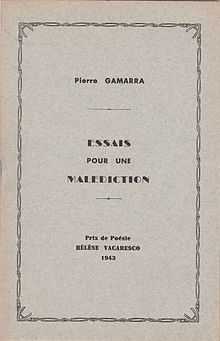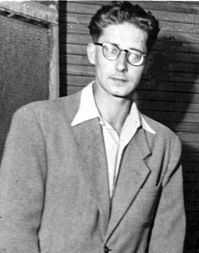Pierre Gamarra
| Pierre Gamarra | |
|---|---|
|
Pierre Gamarra in Toulouse, 1945 | |
| Born |
Pierre Albert Gamarra 10 July 1919 Toulouse, France |
| Died |
20 May 2009 Argenteuil, France |
| Occupation | Writer |
| Nationality | French |
| Genre | Novel, Children's literature, Fable, Poetry, Essay |
| Subject | Toulouse, Midi-Pyrénées |
| Notable works |
|
| Notable awards |
|
|
| |
| Signature |
|
| French literature |
|---|
| by category |
| French literary history |
| French writers |
|
| Portals |
|
Pierre Gamarra (French pronunciation: [pjɛʁ gamaˈʁa]; 10 July 1919 – 20 May 2009) was a French writer. He was a poet, novelist and literary critic.
He is best known for his poems and novels for the youth. He has often depicted his native region of Midi-Pyrénées in his works. Pierre Gamarra was also chief editor and director of the literary magazine Europe.
Life
Pierre Gamarra was born in Toulouse in 1919. From 1938 until 1940, he was a teacher in the South of France. During the German Occupation, he joined various Resistance groups in Toulouse, involved in the writing and distributing of clandestine publications. This led him to a career as a journalist, and then, more specifically both as a writer and a literary journalist.[1]
In 1948, Pierre Gamarra received the first Charles-Veillon International Grand Prize in Lausanne for his first novel, La Maison de feu.[n 1] Members of the 1948 Veillon Prize jury included writers André Chamson, Vercors, Franz Hellens and Louis Guilloux.[n 2]
From 1945 to 1951, he worked as a journalist in Toulouse. In 1951, Louis Aragon, Jean Cassou and André Chamson offered him a position in Paris as editor-in-chief of the literary magazine Europe.[3] He occupied this position until 1974, when he became director of the magazine. Under Pierre Gamarra's direction, Europe continued the project initiated in 1923 by Romain Rolland and a group of writers.[n 3] For more than 50 years, Pierre Gamarra also contributed to most of the magazines's issues with a book review column named The Typewriter[n 4] which shows the same international curiosity.[4]
His novels often take place in his native South-West of France: he wrote a novel trilogy based on the history of Toulouse and various novels set in that town and in the Garonne region[5] or in the Pyrenees.
John L. Brown in World literature today stated that Pierre Gamarra’s descriptions of Toulouse, its people and its region were “masterly”, “skillfully and poetically” composed “with a vibrant lyricism”.[6]
Pierre Gamarra is also the author of The Midnight Roosters,[n 5] a novel set in Aveyron during the French Revolution.[7] The book was adapted for the French television channel FR3 in 1973. The film, casting Claude Brosset , was shot in the town of Najac.[8]
In 1955, he published one of his best known novels, Le Maître d’école;[n 6] the book and its sequel La Femme de Simon[n 7] (1962) received critical praise.[9]
In 1961, Pierre Gamarra received the Prix Jeunesse for L'Aventure du Serpent àn Plumes[n 8] and in 1985, the SGDL Grand Prize[n 9] for his novel Le Fleuve Palimpseste.[n 10]
Pierre Gamarra died in May 2009, leaving a substantial body of work, as yet untranslated into English. The Encyclopædia Britannica sees in him a "delightful practitioner with notable drollery and high technical skills"[10] in the art of children's poetry and children's stories. His poems[n 11] and fables[n 12][12] are well known by French schoolchildren.[13]
Selection of works
In French unless otherwise stated
Literature for the youth
Stories
|
|
Fables collections
- Salut, Monsieur de la Fontaine (2005), ill. Frédéric Devienne, ISBN 2-916237-00-3
- La Mandarine et le Mandarin (1970)
Poetry collections
- Mon cartable et autres poèmes à réciter (2006) ISBN 2747901122
- Des mots pour une maman (1984) ISBN 2-7082-2379-8
- Voici des maisons (1979) ISBN 2-7047-0117-2
- Les Mots enchantés (1952)
CD
- Les Aventuriers de l'alphabet (2002) ISBN 2-7404-1278-9
Adaptations
- Les Fariboles de Bolla (1981), La Farandole , original Swedish text and ill. by Gunilla Bergström, ISBN 2-7047-0232-2
Novels
- L'Empreinte de l'ours (2010), De Borée (Sayat) ISBN 9782844949899
- Les Coqs de minuit (new ed. including Rosalie Brousse) 2009, De Borée ISBN 9782844949097
- Le Maître d'école (new ed. including La Femme de Simon) 2008, De Borée ISBN 9782812903007
- Les Lèvres de l’été (1986) ISBN 2-209-05808-2
- Le Fleuve palimpseste PUF (1985) ISBN 9782130385868; SGDL Prize for the novel
- Cantilène occitane (1979) ISBN 9782070385027
- La Femme et le Fleuve[n 13] (1952)
- L’assassin a le prix Goncourt[n 14] (1951)
- Les Enfants du pain noir (1950) ISBN 9782812908491
- La Maison de feu (1948), La Baconnière (Neuchatel)/Éditions de Minuit, Charles Veillon International Prize
- New edition De Borée (2014) ISBN 9782812911491; publisher page of the book (French)
- Toulouse trilogy:
- 72 soleils, 1975 ISBN 9782201013522
- L'Or et le Sang, 1970
- Les Mystères de Toulouse, 1967

Short stories
- Un cadavre; Mange ta soupe, Prix National de la Résistance 1944
Poetry collections
- Mon Pays l'Occitanie (2009), Cahiers de la Lomagne
- Romances de Garonne (1990) ISBN 9782209063390
- Essais pour une malédiction, Hélène Vacaresco Prize for Poetry 1943
About Pierre Gamarra
In French unless otherwise stated
Book reviews in English
- Les Lèvres de l’été reviewed by John L. Brown, World Literature Today, Vol. 61, No. 2, The Diary as Art (Spring, 1987), p. 236 (University of Oklahoma)
- La Maison de feu reviewed by Georgette R. Schuler, Books Abroad, Vol. 23, No. 2 (Spring, 1949), p. 156[15]
Literary journals special issues
- Poésie Première "Tarn en Poésie 2003: Avec Pierre Gamarra"
- Poésie Première No. 29 (2004)
Interviews
- Tohoku University Faculty of Letters Bulletin, No. 27 (Year 2007) (Sendai, Japan)
- Vivre en Val-D’Oise, No. 112, November–December 2008 (Argenteuil)
Homages
- Charles Dobzynski, Michel Delon, Jean Métellus, Roger Bordier, Béatrice Didier, Raymond Jean, Bernard Chambaz, Michel Besnier, Marc Petit, Claude Sicard, Georges-Emmanuel Clancier, Henri Béhar, Gérard Noiret, Francis Combes, in Europe No. 966 (October 2009)
- Les Cahiers de la Lomagne (Los Quasèrns de la Lomanha), No. 15 (Year 2009), pp. 1 & 16-29
A street in Argenteuil, a school in Montauban and two public libraries (one in Argenteuil,[16] the other in Andrest) are named after Pierre Gamarra.
Notes
- ↑ La Maison de feu means ″The fiery house″. The novel takes place in Toulouse during the 1930’s.
- ↑ Gathered in La Tour-de-Peilz, the jury also included Léon Bopp , Maurice Zermatten, Charles Guyot, Louis Martin-Chauffier and Robert Vivier.[2]
- ↑ For instance, many issues were devoted to an extensive presentation of countries whose literature is not internationally very well known.
- ↑ In French La Machine à écrire; since 2009, the column is continued in Europe by Jacques Lèbre.
- ↑ In French Les Coqs de Minuit.
- ↑ French for The Schoolmaster.
- ↑ French for Simon’s wife, the hero of both novels, Simon Sermet.
- ↑ L’Aventure du Serpent à Plumes, French for ″The Adventure of the Feathered Snake″, is a novel for the youth.
- ↑ In French, Grand Prix de la Société des gens de lettres pour le roman.
- ↑ Le Fleuve palimpseste, French for ″The Palimpsest river″. The river is the Garonne.
- ↑ Pierre Gamarra’s best known poems include Mon cartable (My schoolbag),[11] My School and The Clock.
- ↑ His best known fables include The Cosmonaut and his host, The Apple, The Ski, The mocked Mocker (Le Moqueur moqué) or The Fly and the Cream. Most of Pierre Gamarra’s fables are collected in La Mandarine et le Mandarin (1970) and in his 2005 fables collection Salut, Monsieur de la Fontaine.
- ↑ French for The Woman and the River. The river is, again, the Garonne.[14]
- ↑ L'assassin a le prix Goncourt (French for ‘The Murderer receives the Goncourt Prize’) is set in Moissac.
See also
References
- ↑ ″This is how a countryside schoolteacher who had been studying at the 'École normale primaire', became, through the turmoil of the Phoney War and the Resistance, a poet, a novelist, a journalist living in the region of Paris, member of the magazine Europe′s editing team for some fifty years.″
(…) c’est ainsi que l’instituteur rural préparé par ses années d’École normale primaire s’est mué, les bouleversements de la drôle de guerre et la Résistance aidant, en un poète, romancier, journaliste vivant en région parisienne, membre pendant quelque cinquante ans du comité de rédaction de la revue Europe (…)
Claude Sicard, ″Pierre Gamarra″ in Balade en Midi-Pyrénées, sur les pas des écrivains, Alexandrines, 2011 (Excerpt on the Publisher website (French)). - ↑ Simone Hauert Annabelle, Year 8, number 85, March 1948 (Lausanne), p.45. See also Le Confédéré (Martigny) number 59, 19 May 1948 p. 2. (Read online).
- ↑ Encyclopédia Universalis: Pierre Gamarra(French).
- ↑ See the Journal tables:
- from 1924 until 2000: Europe tables (by author) on Paris-III University website
- from 2001 until present day: Europe tables (by author by year) on the journal website
- ↑ ″Pierre Gamarra kept for all his life his passion for the region of the Garonne river: it was present in his poems, in his novels, in his stories.″
(Pierre Gamarra conservera toute sa vie une passion pour ces terres de Garonne qui reviendront dans ses poèmes, ses romans, ses récits.)
Alain Nicolas, ″Pierre Gamarra est mort″, L’Humanité, 25 May 2009. (online version(French)) - ↑ John L. Brown, Review of Le Fleuve palimpseste, World Literature Today, Vol. 59, No. 1, Winter, 1985 ISSN 0196-3570.
- ↑ Les Coqs de minuit (1950, reed. 2009) De Borée ISBN 9782844949097
- ↑ "TV adaptation (Les Coqs de Minuit) on the Internet Movie Data Base". Retrieved 9 August 2011.
- ↑ ″The manner of telling is so matter of fact that the tragedy takes one unaware.″, according to Helena M. Ranson, reviewing Le Maître d’école, in Books Abroad, Vol. 31, No. 1, Winter, 1957, ISSN 0006-7431
- ↑ Article Children’s literature (20th century) in Encyclopædia Britannica:
Children’s verse has at least one delightful practitioner in Pierre Gamarra. His Mandarine et le Mandarin contains Fontainesque fables of notable drollery and high technical skill.
- ↑ Mon cartable is for instance chosen in France Inter poetry yearly selection for 2012, read by Guillaume Gallienne : listen online(French).
- ↑ Salut Monsieur de la Fontaine (2005) reviewed on the Printemps des Poètes website.(French)
- ↑ ″His abundant body of work has earned him a prominent place in Children’s literature; his poems are read in schools, taught and learned by heart.″ (Sa frénésie d'écrire lui confère une place de choix dans la littérature enfantine ; on lit ses poèmes dans les écoles, on les enseigne, on les apprend.)
Guillaume de Toulouse-Lautrec, foreword to Mon pays l'Occitanie, 2009, p. 12. - ↑ Armen Kalfayan, Review of La Femme et le Fleuve, Books Abroad Vol. 26, No. 3, Summer, 1952
- ↑ List of reviews in English of Pierre Gamarra’s books, on Worldcat.
- ↑ Pierre Gamarra Library in Argenteuil page. (French)
External resources
|
|
|
